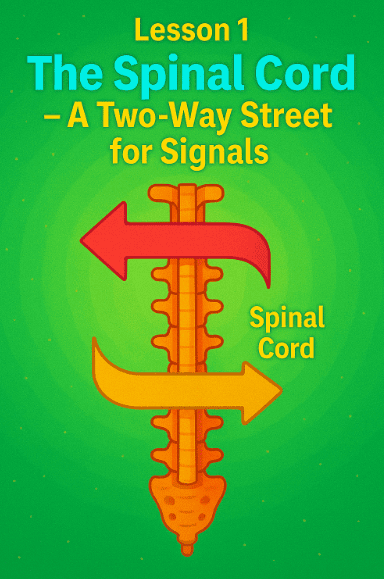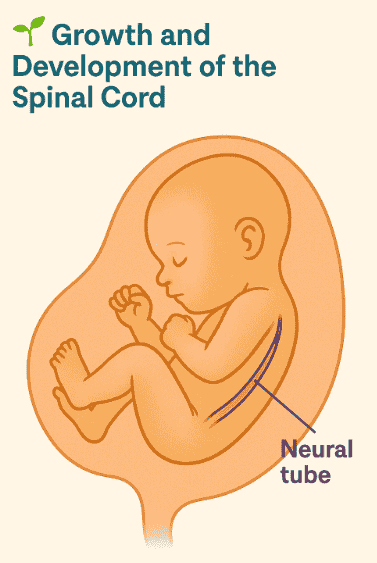
🔄 Recap of Topic 2
In Topic 2, we explored the brain as the master computer:
-
The lobes of the cerebrum, each like a department with a special job.
-
The thinking brain (cerebrum) versus the survival brain (brainstem).
-
The limbic system, the emotional brain that handles memory, fear, and feelings.
-
The cerebellum, the balance coach that smooths movements and builds muscle memory.
But the brain cannot act alone. It needs a way to send and receive messages to and from the body. That’s where the spinal cord comes in.
🌍 Step 1: What is the Spinal Cord?
The spinal cord is a long, tube-like bundle of nerves that runs from the brainstem down through the center of your back.
-
Length: about 40–45 cm (about the length of your forearm plus hand).
-
Thickness: about as wide as your thumb.
-
Protection: wrapped inside the bones of the spine (vertebrae).
It is like the main highway of your nervous system, carrying signals in two directions:
-
Upward: from your body to your brain (sensory information).
-
Downward: from your brain to your body (motor commands).
That’s why we call it a two-way street for signals.
🛣️ Step 2: Why Do We Call It a Highway?
Imagine a big city. The downtown (brain) makes all the decisions, but goods and people must travel along highways to reach the suburbs (body).
-
The spinal cord = the main highway.
-
The nerves branching off = exits leading to towns and villages (arms, legs, organs).
-
The signals traveling up and down = cars on the road.
Without the spinal cord, the brain’s messages could never reach the body, and the body’s signals could never reach the brain.
🧩 Step 3: What Does the Spinal Cord Carry?
The spinal cord carries two kinds of messages:
-
Sensory signals (body → brain)
-
Touching a soft blanket 🛏️
-
Feeling pain from a pinprick 🩹
-
Knowing your feet are on the ground 👣
-
-
Motor signals (brain → body)
-
Lifting your hand to wave 👋
-
Kicking a ball ⚽
-
Dancing to music 💃
-
Every second, millions of signals zoom along this two-way street.
🗺️ Step 4: Gray Matter vs. White Matter
Inside the spinal cord are two types of tissue:
-
Gray matter (like a butterfly shape in the center): made of neuron cell bodies. This is where signals are processed.
-
White matter (surrounding the gray): made of axons covered in myelin, carrying signals up and down.
Analogy:
-
Gray matter = the traffic control centers 🚦.
-
White matter = the highways where cars zoom 🚗💨.
🕵️ Step 5: How the Spinal Cord Connects to the Body
From the spinal cord, 31 pairs of spinal nerves branch out like exits off a highway.
-
8 pairs in the neck (cervical nerves) – control arms and neck.
-
12 pairs in the chest (thoracic nerves) – control chest and back.
-
5 pairs in the lower back (lumbar nerves) – control legs.
-
5 pairs in the pelvis (sacral nerves) – control bladder, bowel, and lower limbs.
-
1 tiny pair at the very end (coccygeal nerve).
Each pair connects to a specific region of the body, like a postal address system. That’s why doctors can often tell where the spinal cord is damaged just by looking at which part of the body is affected.
🎭 Step 6: Everyday Example – Text Messaging
Think of the spinal cord like your phone’s internet connection:
-
If your brain is WhatsApp 📱, the spinal cord is the internet cable that delivers messages.
-
If the cable is intact, your message reaches your friend instantly.
-
If the cable is cut, the message never arrives.
That’s how vital the spinal cord is—it’s the communication link between brain and body.
🧩 Step 7: Reflexes and the Spinal Cord
Here’s something amazing: not all signals need to travel all the way to the brain.
For urgent situations (like touching something hot), the spinal cord can handle the response itself. This is called a reflex.
We’ll explore reflexes deeply in Lesson 2, but remember:
👉 The spinal cord is not just a messenger. Sometimes it takes charge in emergencies.
⚖️ Step 8: What Happens if the Spinal Cord is Injured?
If the spinal cord is damaged, signals cannot pass.
-
Damage high up (near the neck) can cause paralysis of arms and legs (quadriplegia).
-
Damage lower down may cause paralysis of legs only (paraplegia).
That’s why protecting the spinal cord with helmets, seat belts, and safe movement is so important.
🧠 Fun Fact
A newborn baby’s spinal cord is almost as long as their spine, but as they grow, the spine gets longer while the spinal cord stays shorter. That’s why in adults, the spinal cord ends around the waist, not all the way down.
🔬 Extra Deep Dive: More Wonders of the Spinal Cord
The spinal cord is not just a bundle of wires. It has amazing abilities and hidden features that scientists are still discovering. Let’s explore a few more.
🌱 Growth and Development of the Spinal Cord

When a baby is developing inside the mother’s womb, the spinal cord is one of the very first nervous system structures to form.
In fact, it begins as a tiny tube called the neural tube only a few weeks after conception.
This tube later develops into both the brain and the spinal cord. If something goes wrong during this stage, it can cause conditions like spina bifida, where part of the spinal cord doesn’t close properly.
Doctors today can even perform surgeries on babies before they are born to help correct such problems.
So, the spinal cord is not just a highway—it’s one of the oldest, most ancient parts of our nervous system, built very early in life to ensure survival.
🧬 The Spinal Cord and Autonomic Functions
We usually think of the spinal cord as sending messages for movement or sensation, but it also plays a huge role in controlling automatic body functions that you don’t even think about, such as:
-
Making your heart beat regularly ❤️.
-
Adjusting your blood pressure ⬆️⬇️.
-
Helping you digest food in your intestines 🍎.
These automatic signals are carried by a part of the nervous system called the autonomic nervous system, which has branches running through the spinal cord. So, even when you’re asleep, your spinal cord is still hard at work, making sure your body runs smoothly.
🔄 Communication with the Brain
We said earlier that the spinal cord is a highway. But did you know that it is not just a passive messenger?
The spinal cord actually filters and organizes signals before they even reach the brain. For example:
-
If you lightly brush your sleeve, the spinal cord may filter out that signal so your brain isn’t overwhelmed with constant information.
-
If you step on a sharp rock, the spinal cord prioritizes that signal, making sure the brain pays attention right away.
This filtering system is why you don’t constantly notice the feeling of your clothes against your skin, but you instantly notice pain or injury.
⚡ The Speed of Signals
How fast do signals travel in the spinal cord?
Nerve impulses move at an incredible speed—anywhere between 70 to 120 meters per second. That’s about the speed of a Formula 1 race car 🏎️!
This speed is thanks to the myelin sheath (the fatty coating on axons), which works like insulation on an electric wire, allowing electricity to move faster. Without myelin, signals would crawl much more slowly, and reactions would be delayed.
🧠 Amazing Discoveries: Can the Spinal Cord Learn?
Here’s a surprising fact: even without the brain, the spinal cord can learn patterns.
Scientists have studied people with spinal cord injuries and found that certain repetitive movements (like stepping) can sometimes be retrained using special machines. The spinal cord, by itself, can “remember” rhythms, especially when it comes to walking.
This suggests that the spinal cord is not just a dumb cable—it has its own kind of intelligence. It’s like having a mini-brain running through your back!
🌍 Animal Examples
Different animals use their spinal cords in fascinating ways:
-
Cats: Experiments showed that cats with damaged brains could still walk on a treadmill if their spinal cords received rhythmic stimulation. Their cords alone managed the stepping pattern.
-
Snakes: Because their brains are so far from their tails, their spinal cords handle many reflexes directly. A snake’s tail can still wiggle even if separated from the brain.
-
Sea squirts: These small sea animals start life with a spinal cord-like structure, but once they attach to a rock and stop moving, they actually digest their own spinal cord because they no longer need it.
These examples show that the spinal cord is one of the most ancient and powerful survival tools in the animal kingdom.
💡 Everyday Awareness
Now let’s pause for a moment and think:
Every time you move your legs to walk, every time you feel the hug of a blanket, every time you scratch an itch, your spinal cord is in action.
You rarely think about it, but without your spinal cord, even the smallest everyday activity would be impossible. It is silently working for you, 24 hours a day, 7 days a week, without ever resting.
📝 Recap of Lesson 1
-
The spinal cord is the nervous system’s main highway, carrying signals both ways.
-
Sensory signals travel up to the brain; motor signals travel down to the body.
-
Inside, gray matter processes signals, and white matter carries them.
-
31 pairs of spinal nerves branch out, connecting to all parts of the body.
-
The spinal cord is not just a messenger—it also handles reflexes.
-
Injury to the spinal cord can cut off communication and cause paralysis.